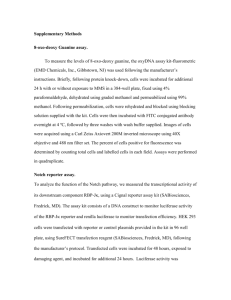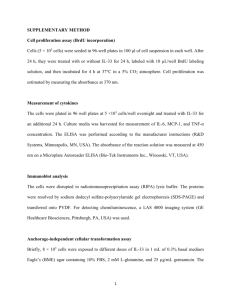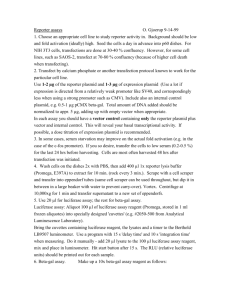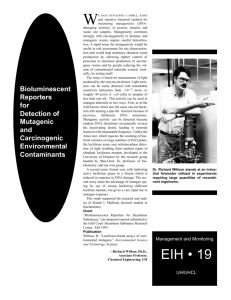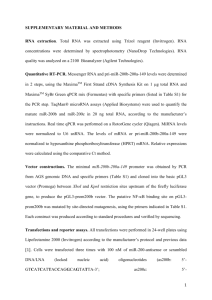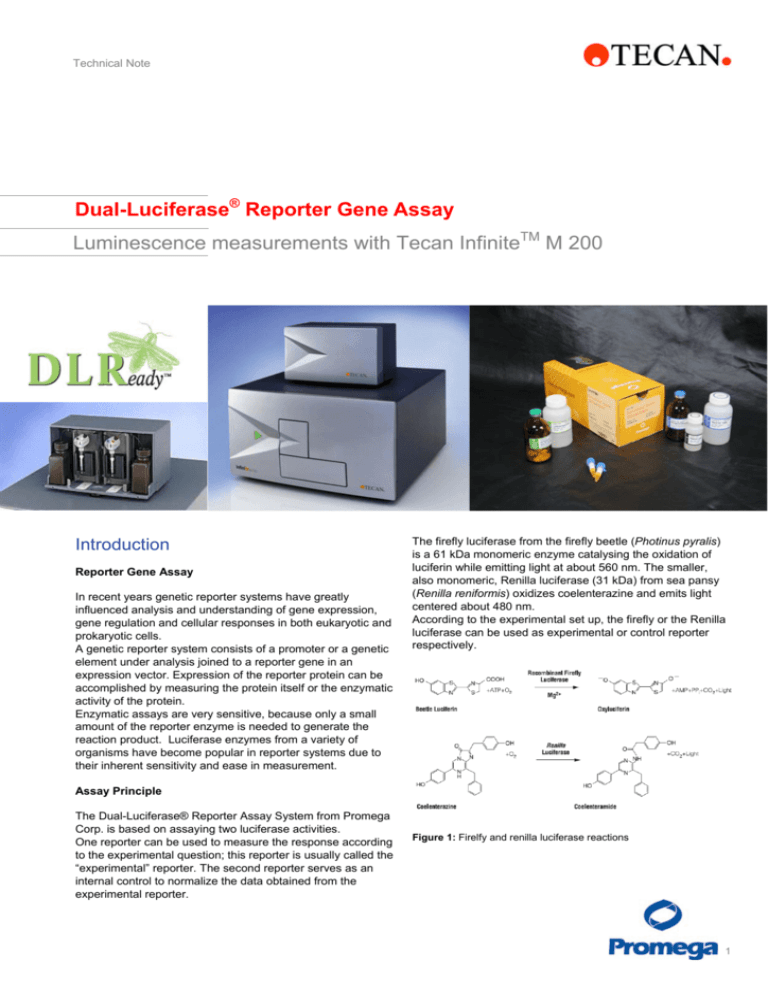
Technical Note
Dual-Luciferase® Reporter Gene Assay
Luminescence measurements with Tecan InfiniteTM M 200
Introduction
Reporter Gene Assay
In recent years genetic reporter systems have greatly
influenced analysis and understanding of gene expression,
gene regulation and cellular responses in both eukaryotic and
prokaryotic cells.
A genetic reporter system consists of a promoter or a genetic
element under analysis joined to a reporter gene in an
expression vector. Expression of the reporter protein can be
accomplished by measuring the protein itself or the enzymatic
activity of the protein.
Enzymatic assays are very sensitive, because only a small
amount of the reporter enzyme is needed to generate the
reaction product. Luciferase enzymes from a variety of
organisms have become popular in reporter systems due to
their inherent sensitivity and ease in measurement.
The firefly luciferase from the firefly beetle (Photinus pyralis)
is a 61 kDa monomeric enzyme catalysing the oxidation of
luciferin while emitting light at about 560 nm. The smaller,
also monomeric, Renilla luciferase (31 kDa) from sea pansy
(Renilla reniformis) oxidizes coelenterazine and emits light
centered about 480 nm.
According to the experimental set up, the firefly or the Renilla
luciferase can be used as experimental or control reporter
respectively.
Assay Principle
The Dual-Luciferase® Reporter Assay System from Promega
Corp. is based on assaying two luciferase activities.
One reporter can be used to measure the response according
to the experimental question; this reporter is usually called the
“experimental” reporter. The second reporter serves as an
internal control to normalize the data obtained from the
experimental reporter.
Figure 1: Firelfy and renilla luciferase reactions
1
Technical Note
For the Dual Luciferase Reporter Assay, the activity of the
firefly luciferase and the Renilla luciferase are determined
sequentially. Therefore, in each well of a micro plate to be
analysed 100 µl of the firefly luciferase reagent (LAR II) is
injected into a well containing a sample cell lysate. The light
output over 10 sec is measured, and then 100 µl of the
reagent for the second luciferase (Stop & Glo® Reagent) is
injected and again the light output is measured. The second
reagent stops (quenches) the first reaction and delivers the
substrate for Renilla luciferase reaction.
This note describes the Dual Luciferase Reporter Assay
TM
performance using Tecan´s Infinite M 200 multimode
reader equipped with a two channel injector.
Material and Methods
Instrument
• Tecan Infinite M200 micro plate reader
(Tecan Austria, Austria)
Microplates
• 96 well flat bottom white Polystyrol micro plates, Lumitrac
200 (Greiner Bio-one, Germany)
Reagents
• Dual-Luciferase® Reporter Assay System (Promega, MA)
• QuantiLum® Recombinant Firefly Luciferase
(Promega, MA)
• Recombinant Renilla Luciferase
(LUX Biotechnology, UK)
Assay procedure
1. Thaw the reagents and prepare Luciferase Assay Reagent
II (LARII), Stop&Glow Reagent (S&GR), and 1x PLB
containing 1 mg/ml gelatine (1xPLB/G) according to the
manufactors instructions and let equilibrate to room
temperature.
2. While preparing the reagents switch on the Infinite M 200
instrument and load the i-Control based DLR measurement
script and heat the instrument for about 30 min to the
temperature the assay should be performed using the
`Heating` feature.
3. Prime injector A with LARII and injector B with S&GR.
4. For quenching experiments dilute recombinant firefly
luciferase in PLB/G and add 20 µl to each well of a row of
micro well plate.
5. For experiments showing the firefly and Renilla luciferase
signal independence, recombinant firefly and Renilla
luciferase is diluted in PLB/G and mixed to achieve 1:10 and
10:1 molar ratios for firefly and renilla luciferase, respectively.
For each molar ratio experiment 20 µl of the resp. enzyme
mix is pipetted in two rows (24 wells) of a micro well plate.
6. Place the micro well plate into the reader and start
measurements.
Measurement Parameters
Parameter
Setting
Plate
[GRE96fw]
Luminescence
Mode
well wise
100 µl
Injector A
200 µl / sec
refill after injection
Wait
2 sec
Label 1, integration time
10 sec
100 µl
Injector B
200 µl / sec
refill after injection
Wait
2 sec
Label 2, integration time
10 sec
Table 2: Dual Luminescence Reporter assay measurement
parameter for Infinite M200
Data Analysis
The experimental data, as well as the measurement
parameters were loaded automatically by the i-Control
software to Microsoft Excel for further analysis.
Results and Discussion
The measurement was performed on Tecan´s Infinite M 200
instrument using 96 well white micro plates. Table 1 shows
the efficient quenching of the firefly luciferase reaction.
Sample
Firefly Luciferase
S&G
Quenching
1
5,508,185
74
74,435
2
5,589,571
96
58,225
3
5,540,906
65
85,245
4
5,641,428
94
60,015
5
5,668,053
92
61,609
6
5,522,657
81
68,181
7
5,521,004
84
65,726
8
5,504,265
9
5,594,167
72
71
76,448
78,791
10
5,515,535
90
61,284
11
5,432,539
86
63,169
12
5,375,449
89
60,398
Average
5,534,480
CV (%)
1.48
67,794
Table 1: Quenching of the Firefly Luciferase. Firefly Luciferase
reaction was quenched by adding 100 µl Stop&Glow reagent.
Quenching was calculated after blanking determined RLU values.
2
Technical Note
Figure 2 shows the graphical summary of the firefly and
Renilla luciferase light output when mixed in different molar
ratios (1:10 and 10:1 resp.) and measured sequentially. There
was no interference of the light output observed and
furthermore it could be shown that the signals measured over
24 wells are very consistent, with coefficients of variation of
about 1.5 – 2.7 %.
6,000,000
5,000,000
4,000,000
3,000,000
2,000,000
1,000,000
0
1
3
5
7
9
11
13
15
17
19
21
23
Figure 2: Firelfy and Renilla luciferase signal independence. Firefly
and Renilla luciferase were mixed to achieve 1:10 and 10:1 molar
ratios, respectively and RLUs were measured. Firefly () and Renilla
() luciferase 10:1; and firefly () and Renilla (c) 1:10.
Conclusion
This technical note describes the successful performance of
Promega´s Dual Luciferase Reporter Assay on the Tecan
Infinite M 200 multiple mode detection reader.
For performing the Dual Luciferase Reporter Assay, some
precautions must be taken which can be easily achieved with
Tecan´s Infinite M 200 Reader.
As is true for many enzymatic reactions, the luciferase
reaction is temperature dependent. Therefore it is advisable
to let the instrument equilibrate for a minimum of 30 minutes
to the temperature the assay reaction is performed. This can
be achieved by the instrument feature `Heating` to obtain a
homogenous temperature within the instrument.
Because of the high sensitivity of luciferase assays, proper
instrument maintenance is a critical issue. Before running a
Dual Luciferase Reporter assay the injectors should be
cleaned very carefully.
We suggest removing all the liquid within the tubing system
before priming the injectors with the assay reagents to
prevent reagent dilution or contamination.
After performing the assays it is recommended to clean the
injectors and tubing first with distilled water and then with 70
% Ethanol for 30 min. This procedure efficiently removes the
Stop&Glow reagent, which has a reversible adsorption to
some kinds of plastic material. Tecan injector systems use
high quality Teflon tubings, which show minimal adsorption of
reagents.
Finally, it must be mentioned that some micro plates have
considerable auto luminescence depending on the material
used for manufacturing. Therefore, micro plates should be
tested for auto luminescence before starting experiments.
For plate with high auto luminescence, the plate must be
dark adapted for ensure quality results.
Acknowledgement
We would like to thank Laurie Engel and Kevin Kopish from
Promega Corp. for their helpful discussions and excellent
support.
Literature
(1) Dual-Luciferase® Reporter Assay System, Instructions for
use (Promega Corp., MA)
List of abbreviations
PLB
PLB/G
RLU
S&GR
Passive Lysis Buffer
Passive Lysis Buffer with gelatine (1 mg/ml)
Relative Light Units
Stop&Glow Reagen
Tecan Group Ltd. makes every effort to include accurate and up-to-date information within this publication, however, it is possible that omissions or errors might
have occurred. Tecan Group Ltd. cannot, therefore, make any representations or warranties, expressed or implied, as to the accuracy or completeness of the
information provided in this publication. Changes in this publication can be made at any time without notice. All mentioned trademarks are protected by law.
For technical details and detailed procedures of the specifications provided in this document please contact your Tecan representative. This brochure may contain
reference to applications and products which are not available in all markets. Please check with your local sales representative.
© 2007, Tecan Trading AG, Switzerland, all rights reserved. Tecan is in major countries a registered trademark of Tecan Group Ltd., Männedorf, Switzerland
395216 V1.0, 08-2007
Infinite M 200 is a trademark of Tecan Group Ltd., Männedorf, Switzerland
DLR and the DLReady logo are trademarks of Promega Corporation. Dual-Luciferase and Stop & Glo are trademarks of Promega Corporation and are registered
with the U. S. Patent and Trademark.
Austria T +43 62 46 89 33 Belgium T +32 15 42 13 19 China T +32 15 42 13 19 Denmark +45 70 23 44 50 France +33 4 72 76 04 80
Germany +49 79 51 94 170 Italy +39 02 215 21 28 Japan +81 44 556 73 11 Netherlands +31 18 34 48 174 Portugal +351 21 000 82 16
Singapore +65 644 41 886 Spain +34 93 490 01 74 Sweden +46 31 75 44 000 Switzerland +41 44 922 89 22 UK +44 118 9300 300
USA +1 919 361 5200 ROW +43 62 46 89 33
www.tecan.com
3

